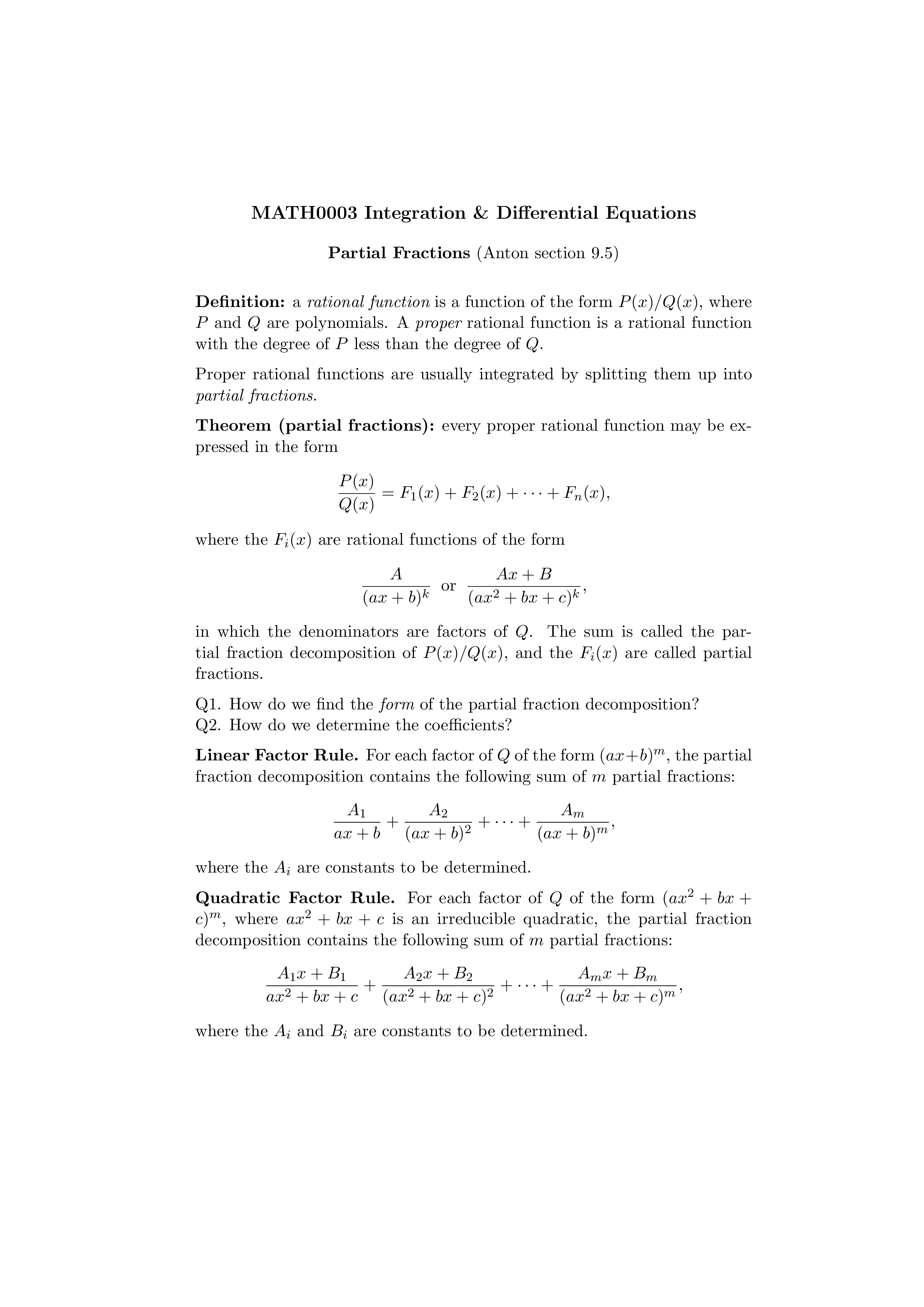Description
The code above is a LaTeX document that begins with the declaration of the document class and page style, followed by the document content enclosed in the "document" environment.
The content includes a centered title consisting of a large bold text "MATH0003 Integration & Differential Equations" and a smaller "Partial Fractions (Anton section 9.5)" line. It also contains a definition of a rational function, a proper rational function, and the method of integrating proper rational functions by splitting them up into partial fractions.
The code includes a theorem about partial fractions decomposition and two questions about the process of finding the form and coefficients of the partial fractions. It also includes two rules, the Linear Factor Rule and the Quadratic Factor Rule, for finding the partial fractions decomposition for factors of a polynomial.
Keywords
documentclass, tikzpicture, draw, node, rectangle, coordinate, fill, circle, label.
Source Code

\documentclass[11pt]{article}
\pagestyle{empty}
\begin{document}
\begin{center}
\large{\bf MATH0003 Integration \& Differential Equations}
\normalsize
\bigskip
{\bf Partial Fractions} (Anton section 9.5)
\end{center}
\medskip
\noindent
{\bf Definition:} a {\em rational function}
is a function of the form $P(x)/Q(x)$,
where $P$ and $Q$ are polynomials.
A {\em proper} rational function is a rational function
with the degree of $P$ less than the degree of $Q$.
\medskip
\noindent
Proper rational functions are usually integrated
by splitting them up into {\em partial fractions}.
\medskip
\noindent
{\bf Theorem (partial fractions):} every proper rational function
may be expressed in the form
\[
\frac{P(x)}{Q(x)} = F_1(x) + F_2(x) + \cdots + F_n(x),
\]
where the $F_i(x)$ are rational functions of the form
\[
\frac{A}{(ax+b)^k} \;\; {\rm or} \;\; \frac{Ax+B}{(ax^2+bx+c)^k},
\]
in which the denominators are factors of $Q$.
The sum is called the partial fraction decomposition of $P(x)/Q(x)$,
and the $F_i(x)$ are called partial fractions.
\medskip
\noindent
Q1. How do we find the {\em form} of the partial fraction decomposition?
\noindent
Q2. How do we determine the coefficients?
\medskip
\noindent
{\bf Linear Factor Rule.}
For each factor of $Q$ of the form $(ax+b)^m$,
the partial fraction decomposition contains
the following sum of $m$ partial fractions:
\[
\frac{A_1}{ax+b} + \frac{A_2}{(ax+b)^2} + \cdots + \frac{A_m}{(ax+b)^m},
\]
where the $A_i$ are constants to be determined.
\medskip
\noindent
{\bf Quadratic Factor Rule.}
For each factor of $Q$ of the form $(ax^2+bx+c)^m$,
where $ax^2+bx+c$ is an irreducible quadratic,
the partial fraction decomposition contains
the following sum of $m$ partial fractions:
\[
\frac{A_1x+B_1}{ax^2+bx+c} + \frac{A_2x+B_2}{(ax^2+bx+c)^2} + \cdots
+ \frac{A_mx+B_m}{(ax^2+bx+c)^m},
\]
where the $A_i$ and $B_i$ are constants to be determined.
\end{document}